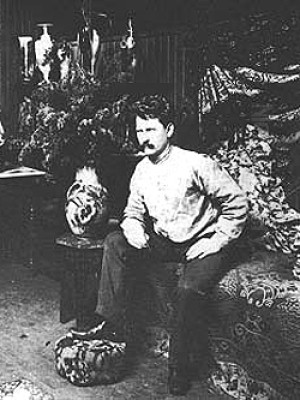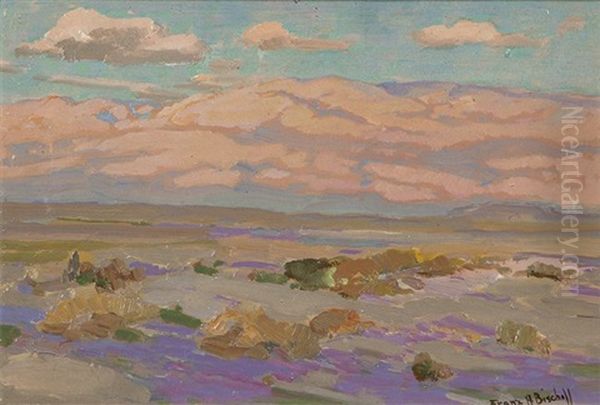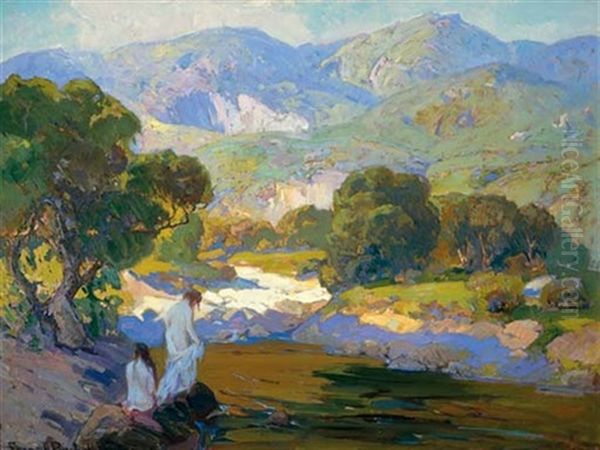
Franz Arthur Bischoff stands as a significant figure in American art history, a versatile talent celebrated for his mastery in two distinct yet demanding fields: ceramic decoration and landscape painting. Born in the heart of Europe, he brought Old World training to the New World, first achieving renown for his exquisite floral designs on porcelain before dedicating the latter part of his career to capturing the vibrant landscapes of California. His journey reflects a transition from the detailed precision of the decorative arts to the expressive freedom of plein-air painting, leaving behind a legacy marked by technical brilliance and a profound connection to the natural world. Bischoff's contributions place him among the key artists who shaped the artistic identity of California in the early 20th century.
European Roots and Artistic Foundation
Franz Arthur Bischoff was born on January 14, 1864, in Steinschönau, Bohemia, then part of the Austrian Empire (now Kamenický Šenov, Czech Republic). This region was renowned for its glass and porcelain industries, an environment that likely fostered his early interest in the decorative arts. Recognizing his burgeoning talent, Bischoff pursued formal art education in Vienna, the imperial capital known for its rich cultural and artistic milieu. In Vienna, he immersed himself in studies encompassing painting, design, and the specialized techniques of ceramic decoration. This comprehensive training provided him with a strong technical foundation and aesthetic sensibility that would underpin his entire artistic career, whether applied to delicate porcelain or expansive canvases. The rigorous academic environment of Vienna instilled in him a dedication to craftsmanship and an understanding of composition and color theory.
Immigration and the Rise of a Ceramic Master

In 1885, seeking broader opportunities, the young Bischoff immigrated to the United States, arriving in New York City. He quickly put his European training to use, finding work as a ceramic decorator. His exceptional skill led him to positions in various cities known for their burgeoning industries, including Pittsburgh, Pennsylvania, Fostoria, Ohio, and Dearborn, Michigan. During this period, he honed his craft, specializing in intricate floral designs, particularly roses, rendered with remarkable delicacy and realism on porcelain. His technical prowess extended beyond mere painting; he became an expert in formulating and applying complex glazes, achieving subtle and luminous color effects that distinguished his work.
His reputation grew rapidly, culminating in the establishment of his own ceramic studio and the Bischoff School of Ceramic Art, likely in Dearborn or Detroit. Here, he not only produced his own highly sought-after pieces but also taught his specialized techniques to aspiring ceramic artists. His mastery, especially in depicting roses with unparalleled grace and utilizing unique glaze formulas, earned him the laudatory title "King of the Rose Painters." His work gained national and international recognition, winning prestigious awards at major expositions, including the World's Columbian Exposition in Chicago (1893), the Exposition Universelle in Paris (1900), and the Louisiana Purchase Exposition in St. Louis (1904). These accolades solidified his status as one of America's foremost ceramic artists, placing his work in the context of the flourishing American Art Pottery movement, alongside esteemed contemporaries associated with Rookwood Pottery or Grueby Faience Company, though Bischoff maintained his distinct, painterly style.
California Beckons: A New Artistic Chapter
While his success in ceramics was undeniable, Bischoff harbored a deep passion for painting, particularly landscape painting. A pivotal moment came in 1900 when he made his first trip to California. He was immediately captivated by the state's diverse scenery and, most importantly, its unique quality of light – a characteristic that would become central to his later work. The experience left a lasting impression, planting the seed for a significant life change.
In 1906, Bischoff decided to relocate permanently to the West Coast, settling in the burgeoning city of Los Angeles. Drawn to the artistic community and the inspiring environment of the Arroyo Seco area, he established a grand home and studio in South Pasadena in 1908. Designed in a striking Italian Renaissance style, this landmark building served not only as his residence but also housed his gallery and a new iteration of his ceramic school, though his focus was increasingly shifting. This move marked a definitive transition in his career, signaling his commitment to exploring the possibilities of landscape painting in his adopted home state. The California environment offered a dramatic contrast to the industrial cities where he had previously worked, providing endless inspiration for his canvases.
The California Landscape: Subject and Inspiration

Upon settling in California, Bischoff fully embraced landscape painting, dedicating himself to capturing the region's multifaceted beauty. Southern California, in particular, offered a wealth of subjects that resonated with his artistic sensibilities. He traveled extensively throughout the state, seeking out diverse terrains and atmospheric conditions. His canvases came to life with depictions of the rugged Pacific coastline, often focusing on the dramatic interplay between cliffs, rocks, and the surging sea, particularly around Laguna Beach and Monterey. The rolling hills and pastoral valleys, dotted with oaks and eucalyptus trees, also frequently appeared in his work.
He was particularly drawn to the unique character of the California deserts, capturing the stark beauty and vibrant colors of areas around Palm Springs, often featuring the seasonal blooms of wildflowers like the California poppy. The majestic Sierra Nevada mountains provided another powerful source of inspiration, their granite peaks and alpine meadows offering opportunities for dramatic compositions. His explorations were not limited to California; in 1912, he traveled with his friend and fellow artist, John Christopher Smith, to Utah, painting the monumental landscapes of Zion National Park, capturing its towering sandstone cliffs and deep canyons. Bischoff joined a growing number of artists flocking to California, including notable figures like William Wendt, often called the "Dean of Southern California landscape painters," Edgar Payne, renowned for his Sierra Nevada scenes, and Granville Redmond, famous for his depictions of poppy fields under the California sun.
Artistic Style: Impressionism, Color, and Expression
Franz Bischoff's painting style evolved throughout his career, reflecting both his foundational training and his response to contemporary art movements and the California environment. While his early ceramic work demonstrated meticulous realism, his landscape paintings increasingly embraced the principles of Impressionism. He became fascinated with capturing the fleeting effects of light and atmosphere, using broken brushwork and a brighter palette to convey the luminosity of the California sunshine. His work shares affinities with American Impressionists like Childe Hassam or John Henry Twachtman, who adapted French Impressionist techniques to American scenes.
However, Bischoff's style pushed beyond traditional Impressionism, particularly in his later years. He developed a bolder, more expressive approach characterized by vibrant, often non-naturalistic color choices and dynamic compositions. This shift aligns his work with aspects of Fauvism and Expressionism, prioritizing emotional impact and decorative effect over strict representation. While perhaps not directly influenced by European Fauves like Henri Matisse or André Derain in the same way some East Coast modernists were, his heightened color sensibility placed him at the forefront of a more modern approach to landscape painting in California. His canvases often sing with intense blues, purples, oranges, and greens, applied with a confidence that reflects both his mastery of pigments (likely informed by his ceramic glaze expertise) and his deep emotional response to the landscape. This bold use of color distinguishes his work from some of his California contemporaries who favored a more Tonalist or purely Impressionist palette.
Masterworks: Capturing Light and Land
Several paintings stand out as representative of Franz Bischoff's mature style and thematic concerns. Titles like Afternoon Meditation suggest serene, contemplative landscapes, perhaps depicting rolling hills bathed in the warm glow of late-day sun, showcasing his ability to capture specific moods and times of day through light and color. In contrast, Rock Coast and Surf likely exemplifies his more dynamic coastal scenes, focusing on the powerful energy of the ocean crashing against the rugged shoreline, rendered with vigorous brushwork and a rich palette to convey the textures of rock, water, and foam.
Other noted works include The Yellow Leaves, suggesting an autumnal scene, perhaps in the Arroyo Seco near his home, where he could explore the brilliant colors of changing foliage. The title York Bridge Bridge (possibly referring to the Colorado Street Bridge or another bridge over the Arroyo Seco, a frequent subject for Arroyo artists) points to his interest in integrating man-made structures within the natural landscape, exploring the interplay of form and light. While detailed analyses of each specific work require viewing them, the titles and Bischoff's known style suggest paintings characterized by strong compositions, a masterful handling of light, and, particularly in his later period, an exuberant and expressive use of color that defined his unique contribution to California landscape painting. These works demonstrate his ability to translate the visual splendor of California into compelling artistic statements.
Community and Collaboration: The California Art Club
Franz Bischoff was not an isolated figure; he actively participated in the burgeoning art community of Southern California. He was a vital early member, and indeed often cited as a founding member, of the California Art Club (CAC), established in 1909. The CAC quickly became the most important and influential art organization in the region, promoting professionalism, organizing major exhibitions, and fostering camaraderie among artists. Its members were largely dedicated to landscape painting, often working en plein air (outdoors) to directly capture the effects of light and atmosphere.
Within the CAC, Bischoff associated with many of the leading artists of the day. His colleagues included Guy Rose, another major figure in California Impressionism who had spent significant time in Giverny; the aforementioned William Wendt and Edgar Payne; Alson S. Clark, known for his sun-drenched depictions of California and European scenes; Maurice Braun, celebrated for his mystical, light-filled landscapes; Hanson Puthuff, another painter of the Southern California landscape; and the talented husband-and-wife duo Elmer Wachtel and Marion Kavanagh Wachtel, both renowned for their sensitive portrayals of the region's hills and valleys. Bischoff's involvement in the CAC provided him with a platform for exhibiting his work and engaging in artistic dialogue, contributing significantly to the development and recognition of California Impressionism as a distinct and vital movement within American art.
Later Years and Enduring Legacy
Franz Bischoff continued to paint actively throughout the 1910s and 1920s, maintaining his studio and gallery in South Pasadena and undertaking painting expeditions. While the advent of World War I reportedly impacted the availability of certain ceramic materials imported from Europe, potentially reinforcing his shift towards oil painting, his primary focus remained the exploration of the California landscape through his increasingly bold and colorful style. He remained a respected figure in the art community until his death.
Franz Arthur Bischoff passed away from heart failure in South Pasadena on February 5, 1929. He left behind a remarkable dual legacy. In the realm of decorative arts, he is remembered as a master ceramicist, the "King of the Rose Painters," whose exquisite porcelain pieces are highly prized by collectors and museums. His technical innovations in glaze chemistry and his delicate artistry set a high standard in the field. In the realm of painting, he is celebrated as a key figure among the early California Impressionists and plein-air painters. His vibrant canvases captured the unique light and diverse scenery of his adopted state with an expressive power and chromatic brilliance that distinguished his work. His journey from Austrian immigrant to nationally recognized artist, bridging the worlds of fine craft and easel painting, marks him as a unique and influential figure in American art history. His paintings continue to be admired for their beauty, technical skill, and evocative portrayal of the American West.
Conclusion
Franz Arthur Bischoff's artistic journey is a compelling narrative of transatlantic migration, technical mastery, and evolving aesthetic vision. From the meticulous floral designs that earned him acclaim as a ceramic artist in the industrial centers of the East and Midwest, to the vibrant, light-filled landscapes that defined his later career in California, Bischoff demonstrated exceptional skill and adaptability. As the "King of the Rose Painters," he achieved the pinnacle of ceramic decoration, while as a landscape painter, he became a leading voice in the California Impressionist movement, capturing the essence of the Golden State with bold color and expressive brushwork. His association with the California Art Club and his influence as a teacher further cemented his importance. Today, Franz Arthur Bischoff is recognized as a significant Austrian-American artist whose contributions enriched both the decorative arts and the tradition of American landscape painting, leaving a legacy as luminous and enduring as the California light he so masterfully depicted.